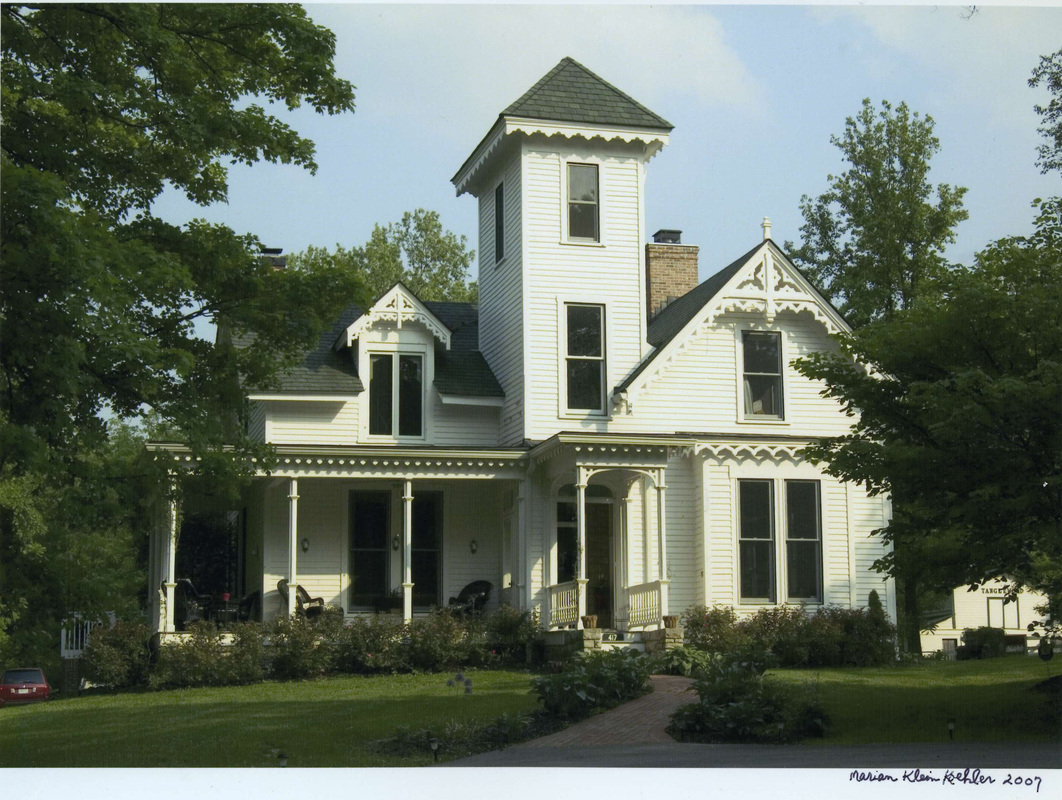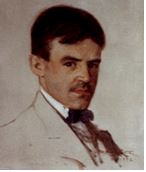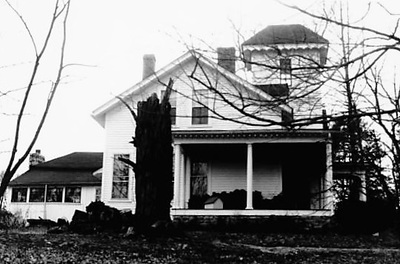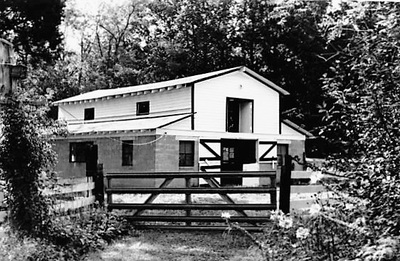Tanglewood: The Barclay Years and Beyond
The Barclay Years
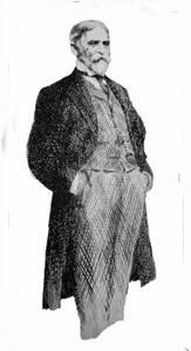 Pen & ink sketch of Rev. Thomas P. Barclay probably by his son, McKee. Courtesy Richard A. Barclay.
Pen & ink sketch of Rev. Thomas P. Barclay probably by his son, McKee. Courtesy Richard A. Barclay.
The information below was compiled with the help of descendant Richard A. Barclay, who has been working for some time on a book about Jonas Rhorer, as well as the Rhorer-Barclay genealogy.
Thomas Philander Barclay (1839-1910) was born in Bowling Green, Ky. He attended Bethel College at Russellville, Ky., for a year and graduated from Centre College in Danville in 1860. He then spent two years working as a partner in his father’s dry-goods business and dabbling in journalism as editor of the Bowling Green Gazette. On April 28, 1864, he married Louisa Rhorer, a decision which eventually brought him to Louisville, where he spent a year working under his father-in-law as Cashier for the Savings Bank of Louisville.
In 1867, he left the bank to go into manufacturing with Jerial George "J. G." or "J. Geo." Dodge. The two men likely met through Jonas Rhorer. Dodge was a resident of Pewee Valley, where he owned two pieces of property, Spottswood (he was descended from the George Washington family) and his country seat, Bellevoir.
Thomas Philander Barclay (1839-1910) was born in Bowling Green, Ky. He attended Bethel College at Russellville, Ky., for a year and graduated from Centre College in Danville in 1860. He then spent two years working as a partner in his father’s dry-goods business and dabbling in journalism as editor of the Bowling Green Gazette. On April 28, 1864, he married Louisa Rhorer, a decision which eventually brought him to Louisville, where he spent a year working under his father-in-law as Cashier for the Savings Bank of Louisville.
In 1867, he left the bank to go into manufacturing with Jerial George "J. G." or "J. Geo." Dodge. The two men likely met through Jonas Rhorer. Dodge was a resident of Pewee Valley, where he owned two pieces of property, Spottswood (he was descended from the George Washington family) and his country seat, Bellevoir.
|
|
Dodge brought considerable expertise to the new concern, which manufactured plows and stock bells on Main Street in Louisville. He had previously been a partner in Brinley, Dodge & Hardy, a farm implement producer located down the street from Dodge & Barclay's new offices. Dodge appears to have left the partnership due to differences of opinion about the firm's direction. In 1862, T.E.C. Brinley and Dodge had together been granted a patent for plow improvements. In 1867, the year the partnership was dissolved, Dodge was granted a patent for a washing machine in July and was assigned exclusive rights to the plow patent by T.E.C. Brinley in October.
Dodge's "Perfect Plow" was put to the test on September 14, 1868 at a trial held at the farm of T. Brown. According to reports on the trial Dodge sent to the Louisville Courier on September 16 and 17, six or seven plows were field-tested, including "...three or four by Brinley and one each by Avery, Brown, Young and Dodge..." Dodge wasn't pleased by the either the judges or the judging -- evidently a Brinley plow won the day -- and proposed a rematch in his September 17th missive: ... I propose to Mr. T.E.C. Brinley, the supposed great "plow king," that if we can select new and unprejudiced judges judges, men like J.B. and Ambrose O'Bannon, W.D. Gallagher, Edward D. Dobbs, George Herr, Simeon and John Garr, and Captain Goslee, men on whom I have no claims of friendship, but men whose honor integrity and purity of purpose is like unto the virtue of Caesar's wife -- above suspicion; men who are practical farmers and who have the moral courage to do what is right, though the (plow) stars fall, and agree that the plow will be judged by the most prominent characteristics that are absolutely necessary to constitute a good plow, I will give him a chance for another report... In June, 1869, Dodge and Barclay took in two additional partners -- Milton M. Rhorer, Jonas H. Rhorer’s brother; and A. Peabody, who probably designed the “Cayuga Chief” single mower -- and renamed the firm Dodge, Rhorer & Co. New partners may have been necessary after the factory was destroyed by a fire that year -- although the loss was completely insured -- or because Dodge's "Perfect Plow" wasn't so perfect after all, and it, as well as Dodge's patented "clothes washer," weren't selling. In 1872, Barclay purchased the interests of all three partners and changed the name of the enterprise to The Kentucky Bell Factory. The plant, which by 1880 had relocated to Jackson street, produced stock bells under the “Kentucky Bell” name. An 1878 report by Winston J. Davie, Commissioner of the State Bureau of Agriculture, Horticulture and Statistics, “Kentucky: It’s Resources and Present Condition” (S.I.M. Major, Frankfort, Ky; 1878), noted that, “Louisville has the largest iron works in the Southwest, and the cheapest iron, gas, and water-pipe market in the west. From the Kentucky Bell Foundry, of this city, originates the best cow bells in the world…” According to "The Biographical Encyclopædia of Kentucky of the Dead and Living Men of the Nineteenth Century, Volume 1" by J. M. Armstrong (1878, Kentucky) page 484, at the time Barclay’s manufacturing plant was producing 150,000 to 200,000 bells a year. The Kentucky Bell Factory was a financial success, apparently due primarily to the efforts of Thomas Barclay. But the nagging questions remains: What did Thomas Barclay know about his father-in-law's nefarious activities prior to the confession? When did he become aware of the embezzlement? |
 The Rev. Thomas P. Barclay in Wyethville, Va., 1908
The Rev. Thomas P. Barclay in Wyethville, Va., 1908
In all likelihood, Barclay knew nothing at all and was totally blameless in the whole, sordid affair. He only worked at the bank for a year, before going into business with Dodge. His father-in-law may have pushed for the partnership to keep Barclay from discovering how he'd cooked the books. Barclay then went on to earn a sterling reputation as businessman, according to his profile published in “The Biographical Encyclopedia of Kentucky,” (J.M. Armstrong & Co., Cincinnati, Ohio; 1878), pg. 484:
...as a rule, the Barclays are steady, upright, and industrious; rarely ever seeking or holding office; and being among the most enterprising and successful businessmen of the country."
Plus, he was a devout Christian. At age 16, he joined the Presbyterian Church in Bowling Green and nine years later was ordained a ruling elder. He and his mother-in-law, Louisa Rhorer, were among the founding members of the Pewee Valley Presbyterian Church, where he served as an Elder and the Clerk of Session from 1866 to 1872. Ironically, Barclay was a member of the Session in 1882 when Jonas Rhorer requested “a letter of dismissal.” The request was granted, because Rhorer had been, “...implicated in his business practices in a course of conduct greatly damaging to his Christian profession….”
Barclay was also studying for the ministry and planning to make a career change. In 1885 he passed the Louisville Presbytery's examination and was ordained a Presbyterian minister. It's highly unlikely that the presbytery would have ordained him had he been knowledgeable about or involved in the embezzlement. Barclay would spend the remainder of his life in the ministry. In 1886 Barclay was installed as pastor at Central Presbyterian Church in Princeton, Kentucky, where he served until early 1889. In 1889 he was called to the Presbyterian Church in Fayetteville, NC, where he served for about a year. After that he served as a pastor in Baltimore, MD, and Wytheville, VA.
Finally, a letter from Thomas Barclay, extolling the virtues of a water pump he purchased for his Pewee Valley cistern, appeared in the August 1879 issue of Farmer’ Magazine. From the letter, it seems the Barclays were happily ensconced in their Pewee Valley home and had no knowledge of Rhorer's crimes:
Something Better than Medicines,
THE DOCTORS INDORSE IT.
Louisville, Ky., July 12, 1879. Mr. F. C. Losey, Louisville, Ky.:--Dear Sir :— The pump which I bought of you has been in the cistern on my place in Pewee Valley for four months; I am delighted with it. Last Summer the water in the cistern had such a foul odor, and was so infested with wiggle-tails, that it was hardly fit for any use. This Summer, thanks to the oxygenizing properties of your pump, it is as sweet and pure as when it fell from the clouds. The pump is simply invaluable. If I could not get another I would not sell it for three times its cost. When I consider its other good qualities, I do not see how any other pump can compete with it. My four-year-old boy can pump water with it. There is no danger from freezing, or getting out of order. It is very durable, and all its parts are easily renewed, and its low price puts it within the reach of all. In my opinion it is without a rival. Yours truly, T. P. BARCLAY, Proprietor Kentucky Bell Factory.
 Louisa Rhorer Barclay, ca. 1877. Courtesy Richard A. Barclay.
Louisa Rhorer Barclay, ca. 1877. Courtesy Richard A. Barclay.
Richard Barclay has provided the following profiles of Thomas Barclay's wife, Louisa, and their children:
Louisa Rhorer Barclay (1841-1918)
Louisa was the oldest child of Jonas Huber and Julia Comly Rhorer. She grew up in Louisville and Pewee Valley. In 1864 she married Thomas Philander Barclay. The wedding reception was held at The Locust, the home of her parents. She was known to her family and friends as “Miss Lou,” a gracious and genteel lady.
In a newspaper article probably written by McKee or “Tom Bee” Barclay, she is described as:
[A] true picture of a contented woman, a representative of a fast-disappearing class. The housewife’s cook book and the specimens of her needlework are treasured by her descendants as relics prized beyond compare.
… Measured by the standards of this year of our Lord nineteen-ten, the compiler of [her] book of recipes was guilty of willfully wasting her life. She was foolish in her generation. Her life was centered on her children, her friends, her mission work, her housewifely pursuits, her books, her flowers and her needlework. When in the fullness of years she looked back over her misspent life the realization that she not even once harangued a crowd of low-heeled, high-browed fanatics on the imperative demand for female citizenship didn’t bring her one single pang of shame. The fact that she had been “put on a pedestal” by the men who knew her didn’t humiliate her in the least. She was so steeped in ignorance that police-baiting by suffragettes would have seemed an ill-bred and unladylike form of amusement. As a matter of fact, she had never heard of a “suffragette,” and the only indication of her ideas on the subject of woman’s rights was given when with a mischievous twinkle in her eye she spoke of her appreciation of the views of “Colonel Susan B. Anthony” on the temperance question.
Louisa Rhorer Barclay (1841-1918)
Louisa was the oldest child of Jonas Huber and Julia Comly Rhorer. She grew up in Louisville and Pewee Valley. In 1864 she married Thomas Philander Barclay. The wedding reception was held at The Locust, the home of her parents. She was known to her family and friends as “Miss Lou,” a gracious and genteel lady.
In a newspaper article probably written by McKee or “Tom Bee” Barclay, she is described as:
[A] true picture of a contented woman, a representative of a fast-disappearing class. The housewife’s cook book and the specimens of her needlework are treasured by her descendants as relics prized beyond compare.
… Measured by the standards of this year of our Lord nineteen-ten, the compiler of [her] book of recipes was guilty of willfully wasting her life. She was foolish in her generation. Her life was centered on her children, her friends, her mission work, her housewifely pursuits, her books, her flowers and her needlework. When in the fullness of years she looked back over her misspent life the realization that she not even once harangued a crowd of low-heeled, high-browed fanatics on the imperative demand for female citizenship didn’t bring her one single pang of shame. The fact that she had been “put on a pedestal” by the men who knew her didn’t humiliate her in the least. She was so steeped in ignorance that police-baiting by suffragettes would have seemed an ill-bred and unladylike form of amusement. As a matter of fact, she had never heard of a “suffragette,” and the only indication of her ideas on the subject of woman’s rights was given when with a mischievous twinkle in her eye she spoke of her appreciation of the views of “Colonel Susan B. Anthony” on the temperance question.
 Rev. Jonas Barclay in 1892 at age 27. Courtesy Richard A. Barclay.
Rev. Jonas Barclay in 1892 at age 27. Courtesy Richard A. Barclay.
Rev. Jonas Barclay (1865-1960)
Jonas Barclay studied at the Louisville Male High School; Princeton Collegiate Institute, Princeton, KY (1887); and Centre College and Danville Theological Seminary, Danville, KY (1888-1891). He was the General Secretary of the Young Men’s Christian Association in Steubenville, KY, for one year 1885-1886. He was ordained by the Presbytery of Mecklenburg, NC, in 1891.
During his career in the ministry he served a number of churches in Maryland, North Carolina and Georgia. He was known for being ‘a theologian.’
After graduating from the Danville Theological Seminary he married Lelia Edna Peagram of Gaston, NC. Together they had five children.
Samuel Alexander Barclay II (1867-1918)
Samuel Alexander Barclay was named after his paternal grandfather of Bowling Green. He and his brother Jonas were close companions as young men, active on the Louisville social scene.
Samuel was probably referred to as ‘high spirited.’ On October 26, 1884 The Courier-Journal ran a long article under the subtitle, “Two Young Louisville Bloods Settle a Dispute In a Three-Round-Blood-Spilling Matinee – A Very Silly Encounter,” which describes a fight between Oliver Hall and Samuel Barclay who were “very exemplary young men, in the ordinary acceptation of the term, and have been fast friends…. It seems that Barclay got rather too wild, and when called to account laid the blame on Hall.” Apparently this resulted in Barclay challenging Hall “to meet him in the ring” which Hall tried very hard not to take seriously. With all the accoutrements of a formal duel –formal challenges in writing, seconds, etc. -- the fight finally took place. In three rounds no one was seriously hurt although Hall was unable to come in for a fourth round.
Samuel married Sallie Habaracker James of Louisville, KY, and together they had six children. He died shortly after his mother Louisa and shortly before his brother Thomas.
Jonas Barclay studied at the Louisville Male High School; Princeton Collegiate Institute, Princeton, KY (1887); and Centre College and Danville Theological Seminary, Danville, KY (1888-1891). He was the General Secretary of the Young Men’s Christian Association in Steubenville, KY, for one year 1885-1886. He was ordained by the Presbytery of Mecklenburg, NC, in 1891.
During his career in the ministry he served a number of churches in Maryland, North Carolina and Georgia. He was known for being ‘a theologian.’
After graduating from the Danville Theological Seminary he married Lelia Edna Peagram of Gaston, NC. Together they had five children.
Samuel Alexander Barclay II (1867-1918)
Samuel Alexander Barclay was named after his paternal grandfather of Bowling Green. He and his brother Jonas were close companions as young men, active on the Louisville social scene.
Samuel was probably referred to as ‘high spirited.’ On October 26, 1884 The Courier-Journal ran a long article under the subtitle, “Two Young Louisville Bloods Settle a Dispute In a Three-Round-Blood-Spilling Matinee – A Very Silly Encounter,” which describes a fight between Oliver Hall and Samuel Barclay who were “very exemplary young men, in the ordinary acceptation of the term, and have been fast friends…. It seems that Barclay got rather too wild, and when called to account laid the blame on Hall.” Apparently this resulted in Barclay challenging Hall “to meet him in the ring” which Hall tried very hard not to take seriously. With all the accoutrements of a formal duel –formal challenges in writing, seconds, etc. -- the fight finally took place. In three rounds no one was seriously hurt although Hall was unable to come in for a fourth round.
Samuel married Sallie Habaracker James of Louisville, KY, and together they had six children. He died shortly after his mother Louisa and shortly before his brother Thomas.
McKee Barclay (1869–1940)
McKee was married twice. First to Lena Rutledge Tyler (1869–1989) with whom he had four children and then to Helen Durant Church Yearley who had six children from a previous marriage. They had no birth children.
McKee Barclay began his career at the Banner in Bedford, KY, and later worked at the Paducah Standard. His first work as a cartoonist was done for the Louisville Courier-Journal and the Montgomery, AL, Dispatch. Barclay moved to Baltimore in 1891 to do illustrative work for the Evening World and the Herald, but soon joined the staff of the Baltimore Evening News. He remained at the News until 1908 when he joined the Baltimore Sun. McKee Barclay remained at the Sun until 1920. McKee Barclay made a name for himself with his artistic representations of foreign and domestic leaders during World War I. Barclay continued to work in sales promotions and advertising -- becoming the first president of the Baltimore Advertising Club -- until he died of pneumonia, at the age of 77.
McKee was married twice. First to Lena Rutledge Tyler (1869–1989) with whom he had four children and then to Helen Durant Church Yearley who had six children from a previous marriage. They had no birth children.
McKee Barclay began his career at the Banner in Bedford, KY, and later worked at the Paducah Standard. His first work as a cartoonist was done for the Louisville Courier-Journal and the Montgomery, AL, Dispatch. Barclay moved to Baltimore in 1891 to do illustrative work for the Evening World and the Herald, but soon joined the staff of the Baltimore Evening News. He remained at the News until 1908 when he joined the Baltimore Sun. McKee Barclay remained at the Sun until 1920. McKee Barclay made a name for himself with his artistic representations of foreign and domestic leaders during World War I. Barclay continued to work in sales promotions and advertising -- becoming the first president of the Baltimore Advertising Club -- until he died of pneumonia, at the age of 77.
 "Tom Bee" in 1913 at age 38. Courtesy Richard A. Barclay.
"Tom Bee" in 1913 at age 38. Courtesy Richard A. Barclay.
Thomas Pollard "Tom Bee" Barclay (1875-1918)
Thomas was married to Mary A. Burton, whose family lived in the Baltimore area. Nothing is known about her except that she was born in Maryland in December 1883. They married between 1900 and 1910 at which time they were both living with Gamma Nock, who ran a boarding house in Baltimore, MD. They did not have any children.
During the Spanish American War, Thomas was a member of the Fifth Regiment of the Maryland National Guard and was stationed in Tampa, FL, and Chickamauga, TN, but did not see any active service.
Thomas, who signed his cartoons "Tom Bee" to distinguish himself from his better-known older brother McKee, began working for The Sun newspaper the same day as his brother. Prior to working at The Sun, he worked for the St. Louis Post Dispatch, Pittsburgh Press, Philadelphia Press, and the Baltimore News. The brothers' work alternated in the same space while McKee contributed a series of illustrated articles titled "Thumbnail Sketches" to The Evening Sun, which had been founded in 1910.
He drew inspiration from Pewee Valley for his nationally known “Down Home” cartoons in the Sunday Sun. Cartoons Magazine, Volume 13. page 856, noted:
He was one of the most sensitive of men rather reserved but tender and gentle and he never knowingly injured or hurt the feelings of any person. Naturally he had his likes and dislikes but no one ever knew Tom to knock anybody. He was a queer genius in many ways. He was full of a quiet humor a delightful companion once one knew him well but decidedly shy and many found him somewhat hard to get acquainted with. …The changing styles in women's hats and dresses always furnished him much whimsical material. He had the rare knack of emphasizing the peculiarities of appearance in men and things making them laughable but never cruel. There was nothing cruel about him. And there is no cartoonist in America who could equal him in depicting the character of a child. He seemed to have an almost uncanny insight into the workings of the juvenile mind and could tell in picture almost what a boy or girl might be thinking about the good little boy, the bad little boy, the sissy, the tough guy, the very neat little girl, the tomboy; he loved them all and he drew them as he saw and knew them.
Tom Barclay died in 1918. His death certificate suggested it was probably due to tuberculosis complicated by pneumonia.
Louise Barclay (1877–1949)
Louise Barclay married Guthrie Allison (1874-1952) of Wytheville, VA, in 1901. They had five children. Her husband graduated from the University of Maryland in dentistry but did not practice. When he was elected to be Mayor of Wytheville, to “clean up the town,” he was the youngest mayor in the country. He also served as county treasurer for three terms. Most of his career was as an employee of the Seaboard Airline Rail Road.
Thomas was married to Mary A. Burton, whose family lived in the Baltimore area. Nothing is known about her except that she was born in Maryland in December 1883. They married between 1900 and 1910 at which time they were both living with Gamma Nock, who ran a boarding house in Baltimore, MD. They did not have any children.
During the Spanish American War, Thomas was a member of the Fifth Regiment of the Maryland National Guard and was stationed in Tampa, FL, and Chickamauga, TN, but did not see any active service.
Thomas, who signed his cartoons "Tom Bee" to distinguish himself from his better-known older brother McKee, began working for The Sun newspaper the same day as his brother. Prior to working at The Sun, he worked for the St. Louis Post Dispatch, Pittsburgh Press, Philadelphia Press, and the Baltimore News. The brothers' work alternated in the same space while McKee contributed a series of illustrated articles titled "Thumbnail Sketches" to The Evening Sun, which had been founded in 1910.
He drew inspiration from Pewee Valley for his nationally known “Down Home” cartoons in the Sunday Sun. Cartoons Magazine, Volume 13. page 856, noted:
He was one of the most sensitive of men rather reserved but tender and gentle and he never knowingly injured or hurt the feelings of any person. Naturally he had his likes and dislikes but no one ever knew Tom to knock anybody. He was a queer genius in many ways. He was full of a quiet humor a delightful companion once one knew him well but decidedly shy and many found him somewhat hard to get acquainted with. …The changing styles in women's hats and dresses always furnished him much whimsical material. He had the rare knack of emphasizing the peculiarities of appearance in men and things making them laughable but never cruel. There was nothing cruel about him. And there is no cartoonist in America who could equal him in depicting the character of a child. He seemed to have an almost uncanny insight into the workings of the juvenile mind and could tell in picture almost what a boy or girl might be thinking about the good little boy, the bad little boy, the sissy, the tough guy, the very neat little girl, the tomboy; he loved them all and he drew them as he saw and knew them.
Tom Barclay died in 1918. His death certificate suggested it was probably due to tuberculosis complicated by pneumonia.
Louise Barclay (1877–1949)
Louise Barclay married Guthrie Allison (1874-1952) of Wytheville, VA, in 1901. They had five children. Her husband graduated from the University of Maryland in dentistry but did not practice. When he was elected to be Mayor of Wytheville, to “clean up the town,” he was the youngest mayor in the country. He also served as county treasurer for three terms. Most of his career was as an employee of the Seaboard Airline Rail Road.
Central Park
Pewee Valley’s present day Central Park, located on Central Avenue behind the Little Colonel Playhouse, isn’t the first city park to go by that name. For a time, the residents of Pewee Valley used the front portion of the acreage now associated with Tanglewood as a public park, marked as Central Park on the 1879 Beers & Lanagan Atlas. A water pump from the city’s drinking well is the only remnant of the park that survives. The park may well have been one of the "improvements and embellishments" carried out by the Building Association that was formed in 1867, and as such, was probably sold in the 1880s to help pay the Savings Bank of Louisville's many creditors.
The Turners and Beyond
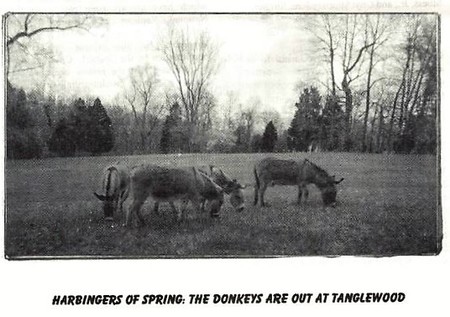 Call of the Pewee April 2005
Call of the Pewee April 2005
In 1884, the Turner family purchased Tanglewood and owned it until 1911. Signatures of A.M. Turner and Henry M. Turner were also found on Tanglewood’s walls during recent renovations. According to the 1910 census, Harry Turner and his wife Clara were living in the house with their 13-year-old daughter Mary. Little else is known about the Turner family.
On May 20, 1911, the Courier-Journal carried a story about the sale of the "old Turner Place:"
LOUISVILLE LAWYER BUYS
PEWEE VALLEY PROPERTY
_________________
Aaron Kohn Purchases Twenty-six-
Acre Farm in Suburb
_________________
The old Turner Place, consisting of twenty-six acres of rich farmland and many improvements, has been purchased by Aaron Kohn, a lawyer, from John W. Gaither. The consideration was around $15,000...The farm is situated just opposite the farm of Powhatan Wooldridge. A modern, two-story frame residence occupies a part of the property....
After Aaron Kohn sold Tanglewood, the house changed hands many times. Research done by the current owners, the Gleasons, shows past owners included the Rubels, Dr. Allen, the Christmans, the Youngs, Dr. John Casper, the Swinneys and the Tinsleys.
The Gleasons purchased it from the Tinsleys in July 1951 and it’s been in the family ever since. For many years, the donkeys and miniature horses the Gleasons raised were a familiar sight to Peweeans driving along Highway 146. An article about the donkeys and how the Gleasons came by them ran in the December 1977 Call of the Pewee:
 Cover photo from the December 1977 Call of the Pewee
Cover photo from the December 1977 Call of the Pewee
The small donkey receiving the big hug on our cover this month (photo at left) is Trixie, a full-grown Mediterranean donkey -- one of five belonging to Mr. and Mrs. Grove Gleason. There are only a few hundred of these little animals in the United States, as it is impractical to import them from their native islands of Sicily and Sardinia, where they provide the motive power for primary milling devices and haul twigs for small stoves for heating. They take charcoal, fruit and vegetables to market -- and then provide transportation to the owner for his return home.
In Sicily, laundry is done at the home of a laundress who places a flat platform on the donkey's back. The folded laundry is placed on the platform, and the laundress rides on top of all, administering an extra press to the clothes she carries back to the owner.
Despite the Miniature's small size, he can pull a considerable load or a cart full of children. These donkeys, which the Gleasons had had for about three months, enjoy a relatively easy life ... sharing an ample pasture with two Mexican burros, Sarah and Teresa.
The miniatures had been only pasture animals, and were rather wild-like when the Gleasons got them. But with the attention of the Gleasons' grandchildren, 9-year-old Kristen, 7-year-old Cynthia, and 3-year-old Gavin, the little donkeys are becoming tamer. By nature, they are gentle, affectionate animals and make wonderful pets.
The Gleasons' herd include two full-grown Jennets -- Fermata and Mamita (one or both is hopefully in foal for the spring); a young Jack, Rickey; and 2 young Jennets named Trixie and Gypsy. When Rickey is 2 years old, he will become head of the herd.
Their adult height, which is 32-37 inches, is not their only distinguishing feature. All have one very prominent marking -- a dark strip that runs down the back and across the shoulders to form a cross. The cross is said to be a mark of honor, for Jesus entered Jerusalem on a donkey, and Mary rode a donkey to Bethlehem where Jesus was born....
In Sicily, laundry is done at the home of a laundress who places a flat platform on the donkey's back. The folded laundry is placed on the platform, and the laundress rides on top of all, administering an extra press to the clothes she carries back to the owner.
Despite the Miniature's small size, he can pull a considerable load or a cart full of children. These donkeys, which the Gleasons had had for about three months, enjoy a relatively easy life ... sharing an ample pasture with two Mexican burros, Sarah and Teresa.
The miniatures had been only pasture animals, and were rather wild-like when the Gleasons got them. But with the attention of the Gleasons' grandchildren, 9-year-old Kristen, 7-year-old Cynthia, and 3-year-old Gavin, the little donkeys are becoming tamer. By nature, they are gentle, affectionate animals and make wonderful pets.
The Gleasons' herd include two full-grown Jennets -- Fermata and Mamita (one or both is hopefully in foal for the spring); a young Jack, Rickey; and 2 young Jennets named Trixie and Gypsy. When Rickey is 2 years old, he will become head of the herd.
Their adult height, which is 32-37 inches, is not their only distinguishing feature. All have one very prominent marking -- a dark strip that runs down the back and across the shoulders to form a cross. The cross is said to be a mark of honor, for Jesus entered Jerusalem on a donkey, and Mary rode a donkey to Bethlehem where Jesus was born....
Photos from the National Register of Historic Places Nomination, 1989
Related Links

